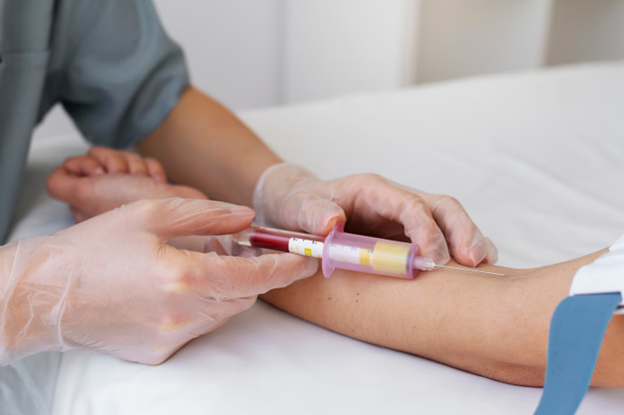People commonly hear about cholesterol in discussions about heart health. Cholesterol is like wax, important for building body cells. Too much cholesterol isn’t good; it can cause heart risks. It’s vital to know how cholesterol works and how it affects heart health.
A lipid panel test checks the types of cholesterol and fats in your blood. This test helps find the chances of heart diseases or related problems. By looking at these parts, doctors understand your health status better. It shows factors that might lead to heart problems or strokes.
This blog aims to make your lipid profile results easy to understand. We simplify them so you grasp how they reflect your health. Our goal is that you’re informed for lifestyle changes or treatments.
What is a Lipid Profile Test and Its Importance?
A lipid profile test is key to checking health.
This test identifies risks for heart disease or strokes early. Spotting these risks early helps manage better heart health.
The lipid panel test checks four parts in your blood:
- Total Cholesterol: This shows all blood cholesterol altogether.
- LDL (Low-Density Lipoprotein): It’s the “bad cholesterol” that clogs arteries.
- HDL (High-Density Lipoprotein): This “good cholesterol” clears bad cholesterol.
- Triglycerides: High levels mean higher risk for heart disease.
Decoding the Components of the Lipid Profile
Your overall lipid panel profile indicates your general cholesterol health status. It shows the amount of different types found in your bloodstream. This number aids in detecting potential risks to your heart’s health.
LDL, or ‘bad cholesterol’, builds up in your artery walls over time. These deposits can eventually clog blood pathways and lead to serious issues. That’s why keeping an eye on its level is vital for staying healthy.
HDL, known as ‘good cholesterol’, helps flush cholesterol out of your system. It removes it from arteries, decreasing blockages, thus improves heart protection.
Triglycerides are fats formed from extra calories stored in your body. High levels might connect to risks for other heart-related problems. Checking triglyceride levels as part of your lipid profile test is essential for overall health.
The Significance of These Lipid Measurements
High levels of LDL cholesterol can harm your arteries. They lead to plaque buildup and narrow blood vessels. This increases the chance of heart attacks and strokes. Keeping LDL and triglycerides low reduces these risks.
Higher amounts of HDL cholesterol are good for the heart. HDL helps remove dangerous cholesterol from your blood vessels. Having more HDL usually means fewer heart problems.
Balancing your lipid levels supports a healthier heart. A good ratio of LDL to HDL is important for wellness. Regular checks of your lipid profile can help you stay healthy. Keeping triglycerides at normal levels supports heart health too.
Performing and Understanding Your Lipid Profile Test
Taking a lipid profile test involves a simple blood draw procedure. During this quick process, a health worker draws blood from your arm.
Your doctor might ask for a fasting lipid profile before testing. This means no food or drinks, except water, for 9-12 hours. Sometimes doctors use a non-fasting method for easier logistics.
The frequency of a lipid panel test varies with individual health needs. Adults should get tested every four to six years, but personalized advice from your doctor is best.
Understanding your lipid profile test results is crucial for your health management. Normal levels show lower risk, while abnormal ones may need changes or further intervention. Discuss results with your healthcare provider for complete insight.
Factors Affecting Lipid Levels and Interventions for Improvement
What you eat affects your cholesterol levels significantly. Eating lots of saturated and trans fats will raise them. But if you load up on fruits and grains, your cholesterol can stay lower. Exercise also helps improve your cholesterol numbers. Working out regularly boosts the good cholesterol and lowers the bad type.
Sometimes, it’s not just how you live that affects your cholesterol levels. If high cholesterol runs in your family, you might face more challenges controlling it. Certain health conditions like diabetes can impact cholesterol levels too. You and your doctor should consider these factors to make better health decisions.
If your cholesterol test shows unusual levels, there are things you can do. Eat a diet that’s heart-friendly with lots of fiber. Regular workouts are important, aim for two and a half hours weekly. Stopping smoking can help improve good cholesterol while protecting your heart.
In some cases, lifestyle changes might not be enough by themselves. Doctors might prescribe medicines such as statins to manage your cholesterol more effectively.
Myths and Realities of Cholesterol and Lipids
Your body needs cholesterol to build new cells properly. HDL, often called the “good” cholesterol, can help clear bad cholesterol. Thus, having high levels of HDL is good for heart health.
Many people overlook the importance of triglycerides in their lipid profiles. Triglycerides are essential because they offer energy but should be kept in check. High triglyceride levels mean a higher risk for heart disease, so monitoring them is key.
A lipid profile test offers a broad view of your heart’s condition. But just looking at numbers isn’t enough; talking to your doctor is crucial. Your doctor can best advise lifestyle changes or when medications are necessary.


